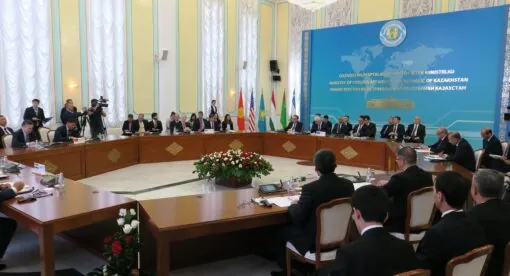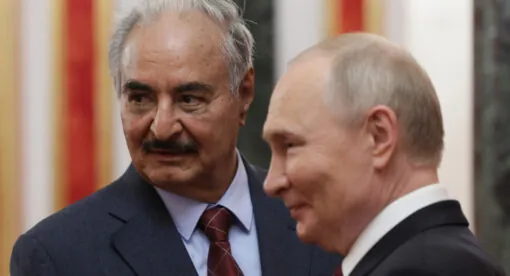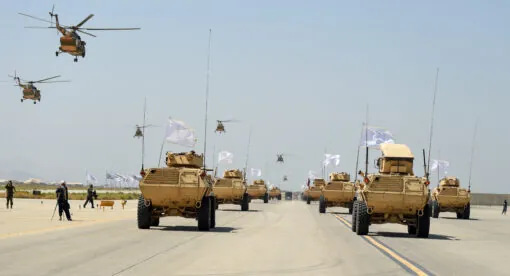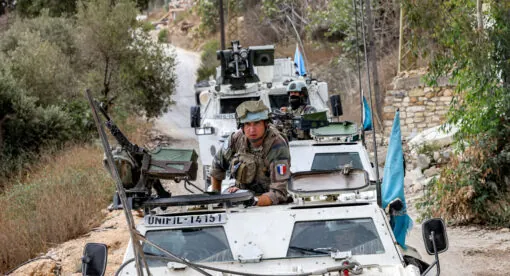Editor’s Note: This Terrain Analysis is part 21 of “ISIS 2020” – a series of briefings about the current status of the Islamic State by authors from different parts of the region. It is published by the Newlines Institute’s Nonstate Actors program. Parts one, two, three, four, five, six, seven, eight, nine, ten, eleven, twelve, thirteen, fourteen, fifteen, sixteen, seventeen, eighteen, nineteen & twenty have been released weekly since April 28.
More foreign fighters are thought to have joined the Islamic State (ISIS) from the former Soviet Union than from any other region of the world. The most prominent and active contingent came from the North Caucasus in southern Russia. Many of the underlying causes of radicalization and recruitment remain unresolved, and violence and instability may grow in the region in the post-ISIS era. The international community and U.S. government should engage constructively with Russian and local authorities in addressing the legacy of over two decades of fighting in the region, ineffective deradicalization programs, and the impunity and corruption seen as inherent in both government and law enforcement.
It is estimated that a quarter of the approximately 30,000 foreign fighters who came to join ISIS were from the former USSR. The largest percentage of those fighters came from Russia, and Russia is considered to be the country from which more recruits travelled to Syria and Iraq than from any other. Within Russia, by far the largest contingent arrived from the North Caucasus region, a patchwork of republics and ethnicities on the northern slopes and approaches of the Caucasus Mountains, stretching between the Black and Caspian seas in the southwest of the country. Others were ethnic Chechens, also known as Kists, from the southern slopes of the Caucasus in Georgia, or Chechen émigrés who had settled mostly in European countries. The largest groups were Chechen or from Dagestan – according to some estimates, up to 5,000 men, women and children.
Many of these people have died or remain in captivity in Syria and Iraq, especially the men. In contrast to other nations, after the defeat of ISIS Russia repatriated several waves of women and children and continues to bring children back – often separating them from their mothers who remain behind in prisons and camps.
The exodus of radical Muslims from Russia to Syria and Iraq from 2012 to 2017 helped stabilize a turbulent situation in the North Caucasus, where an increasingly Islamist insurgency had been evolving for nearly 20 years; there is evidence that the Russian government actively facilitated potential militants in leaving the region for Turkey.
Violence has steeply fallen in the North Caucasus from the levels seen around 2016. But over that period ISIS has eclipsed other militant organizations in the region, such as the Caucasus Emirate. Field work conducted by the second author of this terrain assessment, Mairbek Vatchagaev, based on interviews with Chechens living in Chechnya, Moscow and Western Europe as well as the research of leading experts such as Katya Sokirianskaia of the Conflict Analysis and Prevention Center and Dr. Akhmet Yarlykapov at MGIMO University in Moscow suggests that sympathy for the group and its aims is high, and there are signs of an uptick in attacks in parts of the region. Meanwhile, the failure of local and federal authorities to resolve the underlying causes of radicalization in the region, and the closure of an exit available for radicals to the Middle East, make experts certain that it is not a question of if, but when a new wave of violence will begin.
The Emergence of ISIS in the North Caucasus

The North Caucasus has been the scene of fighting between indigenous populations and an encroaching Russian presence for centuries. The most recent phase began in 1994, when the Russian military attempted to crush a bid for independence in Chechnya. Over the course of two wars and beyond, resistance to Moscow’s rule evolved first into a regional campaign, drawing increasingly from a radical Islamist agenda and spreading across the North Caucasus, most particularly in Dagestan to the east of Chechnya but also Ingushetia and Kabardino-Balkaria to the west. Militants gradually came to see themselves as part of a global Islamist struggle, with most of the region’s radical groups declaring allegiance to the Islamic State in 2014 and 2015.
Central to the spread of operations across the North Caucasus region was the Caucasus Emirate, formally proclaimed in 2007 to replace the simultaneously abolished rebel Chechen Republic of Ichkeria, and an acknowledgement of increasingly active underground groups across the region. It was also a reflection of the growing appeal of radical Islamism across the region in response to the Russian military presence, often heavy-handed policing, and local corruption. Local leaders emerged, and growing ties developed with figures in the global jihadist movement such as al Qaeda leader Ayman al-Zawahiri.
Violence became widespread and constant. In 2011, independent news website Caucasus Knot counted 1,378 victims of violence in the region, of whom 750 were killed. The group also claimed responsibility for a series of attacks on civilian targets in Russia beyond the Caucasus region: a train bombing in 2009, metro bombings in Moscow in 2010, and the bombing of Moscow’s Domodedovo Airport in 2011.
Local elites and law enforcement mounted increasing pressure on militants, with police operations and shootouts in towns and forests eliminating militant leaders and rank-and-file across the region. And the militancy began to be drained from the North Caucasus to a theater that was for many more appealing and less perilous: Syria.
In 2012 it became clear that Chechen and other North Caucasian militants were active in Syria, initially under the banner of the Caucasus Emirate. A growing and independent group called Jaysh al-Muhajirin wal-Ansar, the Army of Migrants and Helpers, received ever growing numbers of fighters from the Caucasus. This group split in 2013, with the larger part – led by the Georgian Chechen Tarkhan Batirashvili, aka Abu Umar al-Shishani – joining and pledging allegiance to ISIS. Other North Caucasus groups of fighters continued to function in Syria and Iraq, and some do to this day, but ISIS gradually became the biggest pull for new militants traveling out of the former Soviet Union. And al-Shishani became a leading commander within the organization, serving as its chief of Syrian military operations until his death in July 2016.
It’s estimated that 5,000 to 10,000 Muslims from the former Soviet Union traveled to Syria and Iraq – perhaps up to 5,000 from the North Caucasus. While anxious about losing valuable fighting assets, the Caucasus Emirate was confronted by the perceived advantages of traveling to an easier location to fight, as well as of gaining military experience against Syrian President Bashar al-Assad’s forces. With ISIS growing in strength in both Syria and Iraq, and the declaration of the caliphate in June 2014, its apparent success became both a pull for militants based in the Caucasus and a challenge to the authority of the Caucasus Emirate.
At the end of 2014, key Caucasus Emirate commanders began to shift their allegiance to a growing ISIS presence in the region. And by mid-2015 – despite the resistance of the Caucasus Emirate leadership – the majority of fighting groups had abandoned the organization to follow the apparently rising star of ISIS. A concerted military effort by Moscow to crush the insurgency in advance of the 2014 Sochi Winter Olympics is thought to have resulted in the killing of hundreds of fighters. At the same time, an apparent policy among authorities in the region proposing and facilitating the exit of radicals and potential militants to Turkey in the run-up to the Olympics is thought to have increased an already busy flow out of the country.
The Caucasus Emirate was effectively replaced by a regional branch of ISIS called Vilayat Kavkaz, following the Arabic of Wilayat al-Qawqaz – Caucasus Province. ISIS spokesman Abu Mohammad al-Adnani named the former head of the Caucasus Emirate’s Dagestan Vilayat, Rustam Asilderov, as the group’s leader. The group claimed its first attack in September 2015, on a Russian military barrack in Magaramkent in southern Dagestan. Soon after, Asilderov released a video in which he called on militants to remain in the region to fight rather than depart for Iraq and Syria. In December 2016, Asilderov was killed by Russian security forces in Makhachkala, Dagestan.
If militants who remained in the Caucasus had hoped that association with ISIS would bring them much-needed resources and support from outside, however, that military benefit does not appear to have materialized. The loosely coordinated and pervasive structure of militant groups across the region, painstakingly created and maintained by successive generations of fighters in and before the Caucasus Emirate era, was replaced by apparently unconnected ISIS sleeper cells controlled by and directed from outside. Attacks launched by the group have been generally small-scale.
ISIS Operations in the North Caucasus and Across Russia

Since 2011, the number of wounded and killed in violence in the North Caucasus has steadily fallen. In 2017, 134 people were killed and 41 were injured. In 2018, that figure dropped to 79 killed and 25 injured, and over 2019 and the first six months of 2020, 45 were killed and 14 were injured.
Security forces have been successful in cracking down on militancy, and the fall of ISIS has meant ever-decreasing support from outside. And yet attacks have persisted both in the region and further across Russia.
Since 2015, ISIS has claimed responsibility for around 30 attacks over the region. Most have been small-scale, and in most cases, the militants were killed during or immediately after.
In the same period, ISIS increased its activity outside the North Caucasus region:
Dec. 27, 2017: A bomb blast in a St. Petersburg shop wounded 27.
May 5, 2018: Gunmen attacked police in Nizhny Novgorod in 2016, wounding three.
April 4, 2017: Gunmen attacked police in Astrakhan, killing two.
Aug. 19, 2018: A knife attack in Surgut, Siberia, wounded seven people.
In addition, ISIS claimed responsibility for the downing of an airliner flying Russian tourists home from Egypt in October 2015, killing all 224 passengers and crew.
According to the Russian security forces, these attacks are just the tip of the iceberg. Reports of prevented terrorist attacks, often connected to ISIS, are frequent. In his yearly reports to the media, FSB Director Alexander Bortnikov has announced the following successes on Russian soil:
2017 – 61 terrorism-related crimes prevented, including 18 major terrorist attacks; 56 sleeper cells were discovered; over 1,000 militants were arrested, and 78 “terrorists” were killed.
2018 – 70 “international terrorist cells” were broken up, including 38 affiliated to ISIS; 777 active members and accomplices of “international terrorist groups” were detained, including 36 leaders.
2019 – 32 militants were killed, including 9 leaders; 41 group leaders, 241 militants, and 606 accomplices were detained; 39 terrorist attacks were thwarted.
In 2020, the security forces and local authorities have continued to report regular actions they say are targeted at ISIS militants. It is difficult to judge the accuracy of Bortnikov’s reports, but the Russian state certainly acknowledges it has a large-scale challenge with ISIS activity. From the sometimes-scarce information available, it appears that the challenge may be about to grow.
Support for ISIS in the Region
But what level of sympathy and support does ISIS enjoy in the North Caucasus? In a region where freedom of speech and association are severely curtailed – and in parts such as Chechnya where rule under the republic’s pro-Moscow leader Ramzan Kadyrov is totalitarian and intolerant in the extreme – political and religious views can be dangerous and are often a necessarily private matter. But we do have some indications.
Since 2016, it seems that the age of participants in violent actions and attacks has been very young in comparison with previous stages of the conflict. The Caucasus Knot studied the identities of militants who had been wounded or killed in clashes with security forces in the North Caucasus, and found that between 2016 and 2019, almost 90% of militants killed were younger than 35. They also found that the proportion of younger militants is growing: In 2015 70% of fighters wounded or killed were under 35; in 2018, that increased to 95%. In some clashes, for example a series in Grozny in December 2016, all killed were aged 20 or under.
This shift is significant in that the younger generation represents men shaped by events after the second Chechen War, 1999-2000, when the militancy projected itself as part of a global jihadist movement. Moreover, the trend has not abated even after ISIS’ defeat and potential discrediting among its possible followers.

Very little sociological data is available on young people’s support or sympathy for ISIS, but in 2015 the Dagestan Ministry for Youth Affairs conducted a large-scale survey across the population in the republic and found some startling results: 8.1% of young people interviewed stated that they were ready to join the Islamic State, while another 30.8% were undecided. According to respected academics such as Dr. Akhmet Yarlykapov – himself from Dagestan and now an academic at the prestigious MGIMO University in Moscow who conducts regular fieldwork in the Caucasus – the situation has changed little since the survey.
In Chechnya, and among Chechens more broadly, the picture appears to be similar. From 2016 to 2018 the émigré Chechen historian and political analyst Mairbek Vatchagaev conducted a survey among young Chechens in Chechnya and in Moscow and reached similarly startling findings: Nearly a half of those asked stated that they approved of ISIS activity to a greater or lesser degree. Among students, says Vatchagaev, sympathy for radical Islam was at its greatest, and shared regardless of gender and place of study. Vatchagaev reports that some of his respondents answered that, “If we lost, that means that it wasn’t our time. We’ll await the next opportunity to rebuild IS.”
Local Authorities Exacerbate the Problem
While the pull of ISIS in the North Caucasus drew heavily from its projected image of success, victorious in conflict and historic in establishing a territorial entity supposedly run on Islamic law, profound domestic causes were also at the root of its extraordinary level of recruitment from the region. In the 2015 Dagestan sociological survey, 43% of respondents did not believe they could find personal success in Dagestan, while 24% blamed the growth of Salafism in the republic on the actions of local authorities, identifying corruption and social injustice as key problems.
The region is beset by a combination of heavy-handed security operations, perceived impunity among elites, the absence of meaningful elections, corruption and a pervading sense of the absence of social justice. In Chechnya, practices of extrajudicial execution, abduction, public humiliation, policies wherein families of militants or suspects are blamed and punished for their misdemeanors, and the widespread use of torture all create grievances and the desire for revenge. A 2019 report by the Moscow-based Conflict Analysis and Prevention Centre quoted a former university professor as saying of the authorities, “The more they blame ISIS, the more interest youngsters have in it. It becomes attractive, romanticized. They need heroes … and find them in the wrong places, including ISIS.”
Similar problems and perceptions persist in other parts of the region, if not to such extreme extent. In Dagestan, recruitment is high in prisons, and corruption is a daily fact of life. Elsewhere, Salafism – seen by many young Muslims in the region as an attractive alternative to the rule of local elites who are allies of Moscow – is automatically equated with terrorism, often banned and its followers subject to persecution and arrests.
Meanwhile, although they recognize the scale of the problem of extremism, local authorities are criticized for ineffective or even counterproductive Countering Violent Extremism (or CVE) programs. The Conflict Analysis and Prevention Centre’s 2019 study found that all too often, that policy was “based on the assumption that violent ideology can be defeated by counter-propaganda” without addressing social problems and often without allowing debate even with moderate, nonviolent Salafist figures.
Forecast
If the regional and national governments continue to fail to engage with the underlying causes for radicalization in the North Caucasus, it is hard to see the problem significantly diminishing. With a drop in the age of militants, it is evident that new generations of supporters of ISIS are continuing to appear. Despite a heavily resourced security operation conducted against violent jihad in the region for over two decades, Russia’s North Caucasus remains volatile, with new flashpoints continuing to emerge.
The latest rise in violent incidents in recent months has struck a part of the Northeast Caucasus, where, thanks to a comparatively successful deradicalization program, violence had remained low. In Ingushetia, Chechnya’s neighbor immediately to the west, some six armed attacks have occurred since January.
For regional experts such as Akhmet Yarlykapov, this may be a sign of things to come in the post-ISIS era, and it bodes ill. “An unstable Syria sucked radically inclined young people from the North Caucasus, Central Asia, Bashkiria, and Tatarstan. Now, while the situation in Syria may remain unstable, it has become much harder to arrive and become entrenched there.” And yet people who would in previous years have traveled to fight in Syria now remain behind, boding more violence at home. ISIS itself may evolve, or mutate, but most experts feel that an uptake of radical, violent Islamism is merely a matter of time.
Given the current difficult state of relations between the West and Russia – and with figures like the Chechen leader Ramzan Kadyrov under U.S. sanctions – it is a challenge for Western governments to influence and mitigate the situation. A further difficulty is the hostility with which Russian and Chechen authorities treat civil society actors, particularly those with foreign connections. And yet Western policymakers must find a way to engage with both officials and society in order to promote good governance, effective deradicalization programs, and honest debate at a grassroots level, in order to resolve some of the deep problems destabilizing the region.
Nick Sturdee is a Russian-speaking journalist and documentary maker, mostly for the BBC. Sturdee has closely followed events and travelled extensively in Chechnya and the North Caucasus since 1995, and has made films about North Caucasian fighters and their families in the Middle East. Most recently he made a BBC radio documentary about attacks on Chechen refugees in Europe.
Mairbek Vatchagaev is a Chechen historian and political analyst in the North Caucasus. Vatchagaev was a senior ranking official in the Chechen government of Aslan Maskhadov. He is the co-editor of the journal “Caucasus Survey” (Oxford, UK), and is an author of five books on the history and religion of the North Caucasus.
The views expressed in this article are those of the author and not an official policy or position of the Newlines Institute.






